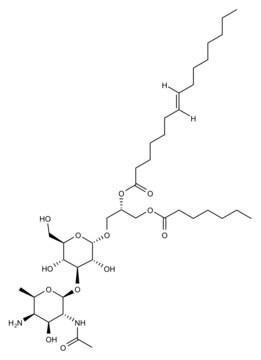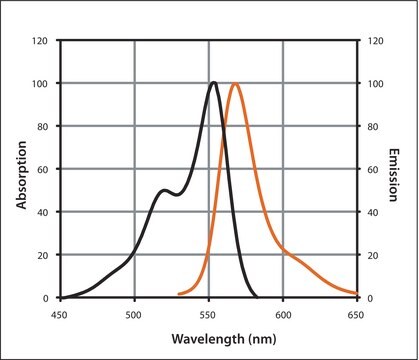L2515
Lipoteichoic acid from Staphylococcus aureus
bacterial cell wall polymer
Faça loginpara ver os preços organizacionais e de contrato
About This Item
Produtos recomendados
fonte biológica
Staphylococcus aureus
Nível de qualidade
Formulário
lyophilized powder
grupo funcional
phospholipid
tipo de lipídio
polymerizable lipids
Condições de expedição
ambient
temperatura de armazenamento
2-8°C
Categorias relacionadas
Descrição geral
Lipoteichoic acid (LTA) is a linear polymer of phosphodiester-linked glycerol phosphate covalently bound to a lipid. The C2 position on the glycerol-phosphate is usually glycosylated or D-alanylated. LTA is amphipathic due to the presence of the negatively charged backbone of glycerol phosphate and the hydrophobic lipid. The lipid portion is bound hydrophobically to the cell membrane, whereas the polyglycerol phosphate portion extends into the cell wall.
Lipoteichoic acid (LTA) is a teichoic acid attached to a lipid abundant on Gram-positive bacteria cell wall. LTA is a pathogen-associated molecular-patterns (PAMP) recognized by Toll-like receptor 2 (TLR2), This recognition leads to the activation of NF-kB.
Aplicação
Lipoteichoic acid from Staphylococcus aureus has been used:
- to investigate the binding properties of SpHyastatin to lipopolysaccharides and lipoteichoic acid using enzyme-linked immunosorbent assay (ELISA)
- to measure the interleukin (IL-6) produced in splenocytes using a sandwich ELISA
- as a toll-like receptor 2/6 (TLR2/6) agonist to explore its potential to induce tumoricidal M1 macrophage phenotype
Ações bioquímicas/fisiológicas
Lipoteichoic acid (LTA) is a complex component of cell walls of Gram-positive bacteria that are involved in a wide range of cell processes such as the stimulation of immune responses and cell signaling pathways. LTA differs between species of gram-positive bacteria. Lipoteichoic acid from Streptococcus aureus may be used to compare its structure, immunogenicity and functions versus other bacterial LTAs.
Lipoteichoic acid (LTA) is a complex component of the cell walls of Gram-positive bacteria that are implicated in a wide range of cellular processes such as the stimulation of immune responses and cell signaling pathways. LTA differs between species of Gram-positive bacteria. Lipoteichoic acid from Streptococcus aureus may be used to compare its structure, immunogenicity, and functions versus other bacterial LTAs.
produto relacionado
Nº do produto
Descrição
Preços
Código de classe de armazenamento
11 - Combustible Solids
Classe de risco de água (WGK)
WGK 3
Ponto de fulgor (°F)
Not applicable
Ponto de fulgor (°C)
Not applicable
Equipamento de proteção individual
Eyeshields, Gloves, type N95 (US)
Escolha uma das versões mais recentes:
Já possui este produto?
Encontre a documentação dos produtos que você adquiriu recentemente na biblioteca de documentos.
Os clientes também visualizaram
Simin Rezania et al.
Cancer cell international, 14, 54-54 (2014-06-27)
Many types of tumors are organized in a hierarchy of heterogeneous cell populations with different molecular signature. Such heterogeneity may be associated with different responsiveness to microenvironment stimuli. In the present study, the effects of lipopolysaccharide (LPS) and lipoteichoic acid
S Morath et al.
The Journal of experimental medicine, 193(3), 393-397 (2001-02-07)
Lipoteichoic acids (LTAs) have been proposed as putative Gram-positive immunostimulatory counterparts to Gram-negative lipopolysaccharides. However, LTA from Staphylococcus aureus, the clinically most frequent Gram-positive pathogen, was inactive after purification. Here, a novel isolation procedure to prepare pure (>99%) biologically active
Varenka J Barbero-Becerra et al.
World journal of gastroenterology, 17(10), 1317-1325 (2011-04-02)
To study the role of gram-positive and gram-negative bacteria in the pathogenesis of liver injury, specifically the activation of inflammatory mediators. Peripheral blood mononuclear cells of 20 out-patients were studied, 10 of them with cirrhosis. Peripheral blood mononuclear cells were
Nien-Tzu Chou et al.
Evidence-based complementary and alternative medicine : eCAM, 2012, 735396-735396 (2013-01-11)
Chlorella sorokiniana (CS) is a unicellular green alga. The extracts of Chlorella have been used as treatments for relieving hypertension and modulating immune response. The detailed mechanisms are not clear yet. In this study, we sought to study the molecular
Gopinath Kasetty et al.
Antimicrobial agents and chemotherapy, 55(6), 2880-2890 (2011-03-16)
Peptides of the C-terminal region of human thrombin are released upon proteolysis and identified in human wounds. In this study, we wanted to investigate minimal determinants, as well as structural features, governing the antimicrobial and immunomodulating activity of this peptide
Nossa equipe de cientistas tem experiência em todas as áreas de pesquisa, incluindo Life Sciences, ciência de materiais, síntese química, cromatografia, química analítica e muitas outras.
Entre em contato com a assistência técnica








